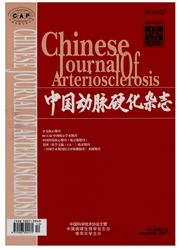

 中文摘要:
中文摘要:
目的探讨自噬干预对低剪切应力下血管内皮细胞内皮型一氧化氮合酶(eNOS)和内皮素1(ET-1)表达的影响。方法 ApoE-/-小鼠高脂饮食喂饲12周,HE染色法观察主动脉病理改变,免疫组织化学法检测自噬标志物Beclin1、微管相关蛋白轻链3Ⅱ(LC3Ⅱ)和p62的表达。人脐静脉内皮细胞和新西兰大白兔颈总动脉置于体外灌流系统,分别以低剪切应力(5 dyne/cm2)和正常剪切应力(15 dyne/cm2)灌流1 h,Western blot检测Beclin1、LC3Ⅱ和p62的表达;在此基础上,自噬抑制剂3-甲基腺嘌呤(3-MA)和自噬激动剂雷帕霉素(rapamycin)孵育低剪切应力处理后的血管内皮细胞和兔颈总动脉30 min,观察自噬干预对低剪切应力诱导的eNOS和ET-1表达的影响。结果动脉粥样硬化斑块中Beclin1、LC3Ⅱ和p62的表达明显增加;与正常剪切应力组相比,低剪切应力组Beclin1、LC3Ⅱ及p62的表达明显增加;雷帕霉素上调低剪切应力下血管内皮细胞以及离体血管eNOS的表达,抑制ET-1的表达;3-MA则进一步抑制血管内皮细胞以及离体血管eNOS的表达,上调ET-1的表达。结论低剪切应力抑制血管内皮细胞自噬从而抑制eNOS表达、上调ET-1表达,增强自噬能改善该过程。
 英文摘要:
英文摘要:
Aim To explore the effect of autophagy intervention on endothelial cells endothelial nitric oxide synthase(eNOS) and endothelin-1(ET-1) expression under low shear stress. Methods ApoE-/-mice were fed with high fat diet for 12 weeks. HE staining was used to detect the pathological changes of aortic sinus. Immunohistochemistry was applied to detect the protein expression of autophagy markers Beclin1,microtubule-associated protein 1 light chain 3(LC3Ⅱ)and p62. Human umbilical vein endothelial cells(HUVEC) and separated New Zealand rabbits common carotid arteries were placed into an in vivo perfusion system with low shear stress(5 dyne /cm2) or normal shear stress(15 dyne/cm2) for 1h,then the expression of Beclin1,LC3Ⅱ/LC3Ⅰ and p62 was measured using Western blot. After treated with 5 dyne /cm2for1 h followed with or without rapamycin or 3-methyladenine(3-MA) for 30 min,the expression of eNOS and ET-1 in human vascular endothelial cells and common arteries of New Zealand rabbits was detected. Results The expression of Beclin1,LC3Ⅱ and p62 was significantly increased in atherosclerotic plaque. Compared with 15 dyne /cm2 treatment group,the expression of Beclin1,LC3Ⅱ and p62 was significantly increased in 5 dyne /cm2 treatment group(P 〈 0. 05). The autophagy inducer rapamycin up-regulated the eNOS expression and inhibited the ET-1 expression in both 5 dyne /cm2 treated HUVEC and common carotid arteries,whereas autophagy inhibitor 3-MA further inhibited eNOS expression and increased the ET-1 expression. Conclusion The inhibition of autophagy might contribute to the decreased expression of eNOS and the increased expression of ET-1 under low shear stress,which was improved by promoting autophagy.
 同期刊论文项目
同期刊论文项目
 同项目期刊论文
同项目期刊论文
 期刊信息
期刊信息
